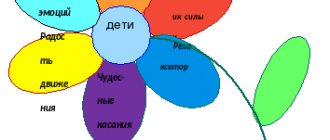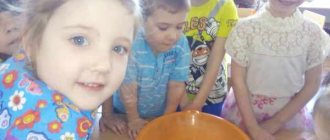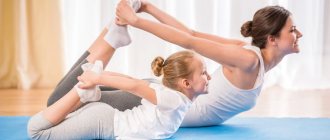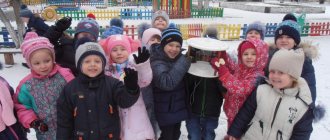Motor mode model for all age groups
Health care – to ensure the protection of the life and promotion of the child’s health. Contribute to the improvement of all functions of the child’s body.
Educational – to form the foundations of physical culture. To form in children initial ideas about healthy lifestyle.
Educational – to cultivate interest in various types of motor activities. To promote the development of positive volitional qualities in the child.
| Motor mode model for all age groups | Junior groups | Middle groups | Senior groups | Preparatory groups |
| Morning exercises | Daily 5-6 min. | Daily 6-8 min. | Daily 8-10 min. | Daily 10-12 min. |
| Physical education minutes | 2-3 min. | 2-3 min. | 2-3 min. | 2-3 min. |
| Music classes | 2 times a week 15 min. | 2 times a week 20 min. | 2 times a week 25 min. | 2 times a week 30 min. |
| Physical education classes (2 indoors, 1 outdoors) | 3 times a week 15 min. | 3 times a week 20 min. | 3 times a week 25 min. | 3 times a week 30 min. |
| Outdoor games: - plot games; - plotless; - fun games; - competitions; - relay races. | Every day at least two games for 5-7 minutes. | Every day at least two games for 7-8 minutes. | Every day at least two games for 8-10 minutes. | Every day at least two games for 10-12 minutes. |
| Health activities: - awakening gymnastics - breathing exercises | Daily 5 min. | Daily 6 min. | Daily 7 min. | Daily 8 min. |
| Physical exercises and game tasks: - articulation gymnastics; — finger gymnastics; - visual gymnastics. | Daily, combining exercises of your choice for 3-5 minutes. | Daily, combining exercises of your choice for 6-8 minutes. | Daily, combining exercises of your choice for 8-10 minutes. | Daily, combining exercises of your choice for 10-15 minutes. |
| Physical education | Once a month up to 15 min. | Once a month up to 20 min. | Once a month up to 30 min. | Once a month up to 40 min |
| Sports festival | 2 times a year up to 30 min. | 2 times a year up to 45 min. | 2 times a year up to 1 hour | 2 times a year up to 1 hour |
| Independent motor activity of children during the day | Daily. The nature and duration depend on the individual characteristics and needs of the children. Conducted under the guidance of a teacher. | |||
Motor mode of the younger group
| Kind of activity | Duration |
| Morning exercises | Daily in a group (in the warm season - on site), 5 min |
| Motor warm-ups | Every day during 10 min. break between classes |
| Physical education minutes | Daily during static exercises, 2-3 min. |
| Outdoor games and exercise while walking | Daily 15-20 min. |
| Individual work on movement development | 2 times a week for a walk of 5-10 minutes. |
| Exercising after a nap | Daily 5-6 min. |
| Physical education classes | 2 times a week for 15 min. |
| Sports walk | 3 times a week for 10 -15 minutes |
| Physical education | Once a quarter, 20-25 min |
| Independent motor activity | Every day, under the guidance of a teacher, indoors and on a walk, the duration depends on the individual characteristics of the children |
Motor mode of the middle group
| Kind of activity | Duration |
| Morning exercises | Daily in a group (in the warm season - on site), 5-6 minutes |
| Motor warm-ups | Every day during a 10-minute break between classes |
| Physical education minutes | Daily during static exercises, 2-3 min. |
| Outdoor games and exercise while walking | Daily 15-20 min. |
| Individual work on movement development | 2 times a week for a walk of 5-10 minutes. |
| Exercising after a nap | Daily 5-6 min. |
| Physical education classes | 2 times a week for 20-25 minutes. |
| Sports walk | 3 times a week for 15-20 minutes |
| Physical education | Once a quarter, 20-25 min |
| Sports holiday | 2 times a year, 45 min. |
| Independent motor activity | Every day, under the guidance of a teacher, indoors and on a walk, the duration depends on the individual characteristics of the children |
Motor mode of the senior group
| Kind of activity | Duration |
| Morning exercises | Daily in a group (in the warm season - on the site), 6-7 min. |
| Motor warm-ups | Every day during a 10-minute break between classes |
| Physical education minutes | Daily during static exercises, 2-3 min. |
| Outdoor games and exercise while walking | Daily 20-25 min. |
| Individual work on movement development | 2 times a week for a 15-minute walk. |
| Exercising after a nap | Daily 5-6 min. |
| Physical education classes | 2 times a week for 30 minutes. |
| Sports walk | 3 times a week for 15-20 minutes. |
| Physical education | Once a month, 30 min |
| Sports holiday | 2 times a year, 1 hour |
| Independent motor activity | Every day, under the guidance of a teacher, indoors and on a walk, the duration depends on the individual characteristics of the children |
Motor mode of the preparatory group
| Kind of activity | Duration |
| Morning exercises | Daily in a group (in the warm season - on site), 6-7 minutes |
| Motor warm-ups | Every day during a 10-minute break between classes |
| Physical education minutes | Daily during static exercises, 2-3 min. |
| Outdoor games and exercise while walking | Daily 20-25 min. |
| Individual work on movement development | 2 times a week for a 15-minute walk. |
| Exercising after a nap | Daily 5-6 min. |
| Physical education classes | 2 times a week for 35 minutes. |
| Sports walk | 3 times a week for 20-25 minutes |
| Physical education | Once a month, 35-40 min. |
| Sports holiday | 2 times a year, 1 hour |
| Independent motor activity | Every day, under the guidance of a teacher, indoors and on a walk, the duration depends on the individual characteristics of the children |
Calendar and thematic planning for physical education in the middle group for October
Calendar-thematic planning of physical education classes in the middle group
October
1
“Those who go in for sports don’t know about diseases”
Penzulaeva L.I. No. 13 page 19, No. 14 page 20 No. 15 page 20
Practice vigorous pushing off the floor and soft landing on bent legs while jumping forward; in throwing the ball over the net.
Develop agility, eye and stable balance when walking on an increased support, in jumping forward.
Braids, gymnastic bench, skittles, sandbags
Motor, play, communication, music
Able to collaborate and perform both leadership and executive functions in collaborative activities; developed fine and gross motor skills; mobile, hardy; masters basic movements, can control and control his movements
October
2
"Olympians Among Us"
Penzulaeva L.I. No. 16, page 21, No. 17 page 22, No. 18 page 22
Practice finding your place in the line after walking and running, landing on bent legs when jumping from hoop to hoop, rolling the ball to each other, walking while performing various jumping tasks.
Strengthen the ability to act on a signal.
Develop accuracy of direction of movement, dexterity and stable balance when walking.
Balls, hoops
Motor, play
Has an idea of the importance of a healthy lifestyle; shows independence in performing exercises. Performs complex exercises only after demonstration.
October
3
"Take care of my heart"
Penzulaeva L.I. No. 19 page 23, No. 20 page 24, No. 21 page 24
Develop the ability to maintain correct posture and consciously perform movements; crawl along the bench on your stomach and back, pulling yourself up with your arms; climb on an inclined board.
Practice rolling the ball like a snake between objects; running between objects placed on the floor; in throwing the ball up and catching it with both hands; in hitting and throwing the ball into the hoop.
Develop dexterity and coordination of movements.
Gymnastic bench, cord with stands, balls, cubes
Motor, play, communication, music
Able to collaborate and perform both leadership and executive functions in collaborative activities; demonstrates the ability to hear others and the desire to be understood by others; developed fine and gross motor skills; can control and control his movements
October
4
"Visiting a fairy tale"
Penzulaeva L.I. No. 22, page 27, No. 23 page 28, No. 24 page 28
To develop the ability to jump up with a running start, reaching for an object suspended 25-30 cm above the child’s raised hand.
Practice running on your toes, jumping from foot to foot while moving forward, walking with changing the position of your hands.
Develop dexterity and coordination of movements.
Cubes, hoops, gymnastic bench
Communicative, gaming, motor, musical
Able to collaborate and perform both leadership and executive functions in collaborative activities; demonstrates the ability to hear others and the desire to be understood by others; developed gross and fine motor skills; can control and control his movements



